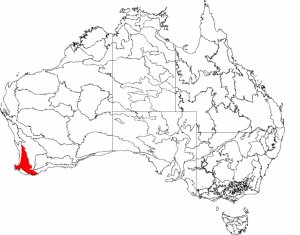 A long time ago, the habitat of the Western Quoll (Dasyurus geoffroii) was huge, it covered desert areas of Central Australia, but that was then. At present, their turf had been significantly cut down to what is known as the Jarrah forests (see picture below). How do the Western Quolls look like: an average of 1.3 kg, they ordinarily have a black/brown coat featured with white areas. The Western Quoll has a short-legged structure, a pale face, big eyes and ears which we could only think of as rounded.
A long time ago, the habitat of the Western Quoll (Dasyurus geoffroii) was huge, it covered desert areas of Central Australia, but that was then. At present, their turf had been significantly cut down to what is known as the Jarrah forests (see picture below). How do the Western Quolls look like: an average of 1.3 kg, they ordinarily have a black/brown coat featured with white areas. The Western Quoll has a short-legged structure, a pale face, big eyes and ears which we could only think of as rounded. Their breeding (reproduction) comes from May to July, where June could be considered as the "heaviest" period. They have a gestation time frame of sixteen to twenty-three days, and a newborn would stay at the mother's pouch for 7-15 weeks, until the time that the newborn Western Quoll could manage to stay out of the said container. These Quolls (both sexes) are considered as sexually capable at just 1 year old.
They are nocturnal creatures. The abode of male Western Quolls are big and cross the areas of females, still, they actually only meet when they need to mate. A Western Quoll can climb tress, and they stay in dens which were built by other creatures.
What exactly does a Western Quoll eat? Well, it encompasses a lot: big insects, vertebrates, carrion even.
A great fraction of their habitat has been eradicated by constant burning and pesticide-application by the farmers, but that is just one reason. Foxes and deadly cats have cut down their population to what it is right now.
Interesting fact: A Western Quoll is capable of killing bigger prey by a bite to the back of its head.

Map of Australia, highlighted is the Jarrah forest, by Hesperian, licensed under GFDL
Picture of the Western Quoll by Nezumi Dumousseau, licensed under Attribution 2.5 License
Keywords: white , brown , tail
The Chuditch, western quoll is listed as Vulnerable (VU), considered to be facing a high risk of extinction in the wild, on the IUCN Red List of Threatened Species
Countries
AustraliaWestern quoll habitats
Desert, Forest, Hot Desert, Shrubland, Subtropical / Tropical Dry forest and Subtropical / Tropical Dry ShrublandSome facts about the
Western quoll
Adult weight : 0.89 kg (1.958 lbs)
Maximum longevity : 6 years
Female maturity :365 days
Gestation : 16 days
Weaning : 158 days
Litter size : 6
Interval between litters : 365 days
Basal metabolic rate : 3 W
Body mass : 1.327 kg (2.9194 lbs)
